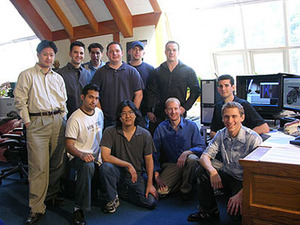
Sandwich and a drink
Of course, having faster systems and swankier hardware doesn't mean much if it doesn't make a tangible difference to the way you work. We've already mentioned one aspect of the workflow that changed with AMD64 technology: JAK films was able to up their output from 4400 shots to 6500 shots over the course of the film. What else changed?"As we worked through Episode III, how we worked was able to change," Dan tells us. "George was able to sit down and direct the action on our workstations. We could change the animations and the art assetts in real time as we worked on new ideas. He came up with a sandwich and a drink every day and sat down with people one-to-one to go through shots."


The pre-vis team at JAK, and Dan working on his dual-Opteron workstation. The standard JAK workstation sports dual AMD Opteron 248 chips, 4GB of PC2700 RAM and NVIDIA QuadroFX 3000 graphics, as well as dual SATA hard drives
"With 64-bit rendering, AMD has allowed Episode III to be all George. He can be in charge of computer graphics work as well as primary photography."
Indeed, the technology has changed a lot between working on Episodes II and III. The change from offline rendering to real-time rendering has clearly enabled a heck of a lot more thought and effort to go into the sequences. Anyone who has seen Episodes II and III will be able to testify to the fact that computer-generated sequences in the latter are directed better and rendered at a higher quality.
It is... your destiny.
So what does the future hold for AMD, JAK, Charlie and Dan?"AMD technology is about changing people from working on a computer to performing on a computer. Our goal is to balance the artistic performance with productive power. Every time an artist has to stop and fiddle with something on the computer, to free up resources or whatever, it's taking him out of the creative process. We want to get rid of that.
"We are starting to look at new ways of evaluating our technology. Before AMD, Intel always used to say that performance was all about MHz. We debunked that with our Athlon processors. We said it was all about real-world application performance. Now, we're not even sure that that is right. We think that we should be measuring the success of our technology based on what people do with it. Star Wars is a wild ride. Our technology has enabled them to do things they couldn't have otherwise done."
For Dan, the future, obviously, doesn't involve more Star Wars. "Towards the end of the Star Wars project, Steven Spielberg called up George and asked if we could work on War of the Worlds. I've formed my own production company, and we're working on several Dreamworks pictures now.
"The techniques we're using are the same as we always have - we build the concepts, build the shots. But I absolutely see games and films converging in the future. It's already gone one way, with movies being made into games. I think it's going to start going with the other way. The graphics technology in today's games is such that people accept it as being sufficient to buy the characters. I think in the future, there's not going to be a reason why we can't make a quality movie in a game engine."
Evangelists of Machinima will certainly welcome the endorsement of such a high profile graphics artist, and today's homegrown film-making scene is only going to get more advanced.

"We're creating awesome technology. We're doing these things because it's the right thing to do. We're interested in a renaissance."
With such passion for creativity, we can't help but be enthused. It's been clear for a long while that AMD has had the drop on Intel when it comes to gaming performance, and on this evidence, it seems like the firm's workstation performance is being endorsed by some heavy hitters. With drop-in dual-core Opterons about to double the rendering power of the systems at Skywalker Ranch, we're pretty hopeful that this might be the beginning of the media-renaissance AMD are so keen to jump-start.

MSI MPG Velox 100R Chassis Review
October 14 2021 | 15:04








Want to comment? Please log in.